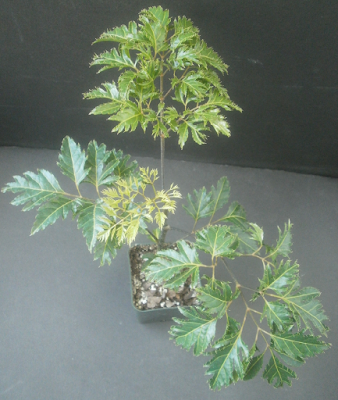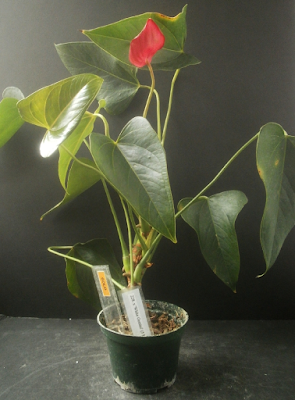So I told you a while back that the plant collection had done one thing that made me happy during the previous three months or so. This is that thing.1
A quick recap of the Polyscias saga so far:
At the end of last May, both my original Polyscias fruticosa and the plant I started from a cutting of it bloomed. I tried to pollinate the flowers, not knowing if it was self-fertile, and got berries. Started the seeds from those berries on vermiculite in late September. To my surprise, the seeds began to germinate in mid-October, and the first seed leaves were visible in early November.
And then I stopped blogging about them, but they continued to do things. Eventually it started to become a problem to keep the vermiculite moistened, so I potted up the sturdiest-looking eleven seedlings on 12 January.
I hadn't been very optimistic about the seedlings. I've never actually done this before with Polyscias, and it's not like I really need more of them. I thought the best case scenario was that I'd get five or six that I could sell at the consignment store or on Craigslist or something, ideally before they got huge.
Instead, all eleven survived. Here they are on 3 February, looking a little yellow:

In March, with all eleven still intact, it started to become apparent that something unexpected was happening. They were starting to diverge in appearance a little. Young leaves aren't necessarily representative of mature foliage, but it got my attention. 11 March:
By April, it was clear that something was up. As each new leaf appeared, the seedlings weren't all converging on a standard "
Polyscias fruticosa" form like I'd expected: instead they were getting more and more distinct from one another in leaf shape, size, amount of branching, etc. And I started to get a little excited. 4 April:
By late April, it was official. Not only were they consistently different in appearance from one another, but they were distinct enough that some of the plants were individually recognizable.
Here are shots of individual leaves
2 from the eleven seedlings, arranged in order of decreasing fluffiness.
3
Seedling 01
Seedling 04
Seedling 05
Seedling 03
Seedling 08
Seedling 06
Seedling 11
Seedling 07
Seedling 02
Seedling 09
Seedling 10
The appearance of the individual seedlings sort of logically follows from the appearance of the leaves, so I'm not sure I actually need to show you the entire plants, but I guess in the interest of completeness, and because I have comments about a few of them, I may as well. Same order:
Seedling 01
Seedling 01 is a monster. The leaves keep getting bigger and more complicated. It's also one of the taller seedlings, though I realize you can't tell that from the photo very well, because of the angle. The veining is also a lot more prominent than on most of the other seedlings, which doesn't mean a lot, but gives the leaves a sort of striped appearance close-up. Which is sort of attractive.
Seedling 04
Seedling 04 is also producing really substantial, three-dimensional leaves, and since this photo was taken, it's also started to branch. (I think technically you can see the beginnings of the branches in this photo, down low on the stem, but they're more obvious now.)
Seedling 05
Seedling 03
Seedling 08
Seedling 08 is also very distinctive because of how narrow all the leaflets are. I don't find it especially
appealing, but I can pick it out of the crowd: 08's the one that looks like a tangled mess. It's possible that it will have some redeeming feature, like being unusually durable or whatever.
Seedling 06
Seedling 11
Seedling 07
Seedling 02
Seedling 02 is either my favorite or second-favorite, along with seedling 01. Doesn't actually look that much like holly, but it nevertheless makes me think of holly.
Seedling 09
It's pulling out of it now, it looks like, but seedling 09 is the only one that's ever seemed to struggle at all; I'm not sure exactly what's wrong with it, but all the leaves suddenly developed yellow-brown spots, more or less evenly-spaced, and the leaf in front, the really yellow one, dropped off. I'm assuming that I overwatered; the spots are plausibly edema.
4
Seedling 10
Seedling 10 is very short but also very thick: one of the first seedlings to start branching. The two things appear to be related. It's like there's only so much vertical growth possible, so the ones that branch tend to be short, and the ones that don't branch wind up tall. Which makes sense, though seedling 04 is both tall and branching, so it's maybe not a firm rule.
So . . . how to explain this, then. I'd never had any reason to suspect that my plant was anything other than a regular old
Polyscias fruticosa, and yet a wild-type species plant, crossed with itself, shouldn't give offspring this varied, should it?
It's possible that my parent plant is a hybrid -- I don't know for sure that
Polyscias species can hybridize with one another, but I don't know that they
can't, and there are other species in cultivation,
5 so surely someone has
tried before. Searching for "polyscias hybrid" turns up pages where both words appear, but the sites all appear to be using "hybrid" interchangeably with "cultivar" or "variety;" there's no "_______ is a hybrid between
P. _____ and
P. ______" anywhere.
It's also possible that maybe
P. fruticosa produces a lot of sports and/or is naturally variable, like
Rhynchostylis gigantea, and all of them have the potential to produce variable offspring. In any case, I'm surprised, don't know how this happened, and am finding it kind of a fun puzzle.
As to whether any of them might be special enough to try to propagate on a larger scale, or patent, or whatever, well, it's still
really early. They're only eight months old, and haven't even broken my heart yet,
6 so let's don't go counting chickens. But I'm really interested in seedlings 01 and 02, especially 02, and I think I can safely assume that they'd propagate true from cuttings, so . . . maybe someday.
-










































